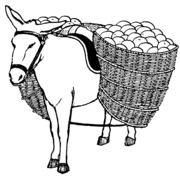Pack animal
Pack animals or pack animals are animals that are used to carry loads , especially in impassable areas today. In Europe, the term primarily includes all tamed equids such as donkeys , mules, mules, horses, ponies and pack goats .
In addition to carrying loads to support life, such as For example, water transport in deserts and dry areas with the help of donkeys, goods transport with dromedary caravans etc., the new use of pack animals for the transport of equipment (tents, sleeping bags, camping accessories), clothing and food on longer hikes can be found more and more in the leisure sector great distances. For this form of pack animal use, the animal species that have long been used in Europe are used, but also llamas, which are indispensable as pack animals in the Andean regions, as well as goats, whose modern use in the USA and Europe only began again in the 1980s, as However, pack animals can be detected much earlier.
In the early Neolithic , with the exploitation of animal potential through domestication, expanded logistical possibilities arose . These animals were initially hunting prey, in domesticated form they initially remained meat animals and then became pack animals, later also draft animals and ultimately mounts. It cannot be determined when pack animals were first used, as there are no early finds of packing facilities such as the Sagma (ancient Greek pack saddle). It remains unclear whether the dog, which can carry loads of up to 15 kg , was used as a pack animal at an early stage.
With the cattle at the latest in the 9th millennium BC. BC domesticated a workhorse that carried weights up to 100 kg. Later domestication resulted in trample (250 kg; 35 km / day), dromedary (150 kg; 50 km / day), horse (150 kg; 30 km / day), donkey (90 kg; 25 km / day), alpaca ( 50 kg; 25 km / day), llama , gaur , reindeer , as well as yak and zebu , which are still in use today as carrying, riding and draft animals in inaccessible areas. In earlier times elephants were also used as pack animals. For use as a pack animal, training lasting several weeks is required, during which this trust in the pack animal handler has to be gained and the pack animal handler gets to know the characteristics of the pack animal.
Packhorsetrails
A distinctive feature of the Pennines in England is their ancient network of pack animal trails that have been used to transport salt from the early Middle Ages to the early modern period. There were even narrow packhorse bridges on the narrow mule tracks.
In military terms, mules , also known as mules, are mostly used as pack animals by the mountain troops . Armed forces that still have pack units at their disposal are the Bundeswehr , French Chasseurs alpins , Italian Alpini , Austria , Swiss mountain infantry brigades , and mountain troops in Peru and Chile.
The US Army and the US Marine Corps want to replace the ability to transport loads with pack animals with autonomous walking load robots. The US company Boston Dynamics developed the Legged Squad Support System LS 3 AlphaDog, which is powered by an internal combustion engine.
See also
Web links
- Statement by IGEM eV on: "Esel Hermann" in action against the Taliban; "Donkey Hermann quits duty" (PDF; 111 kB)
- Recommendations for keeping donkeys (PDF; 720 kB) for other pack animals as well

